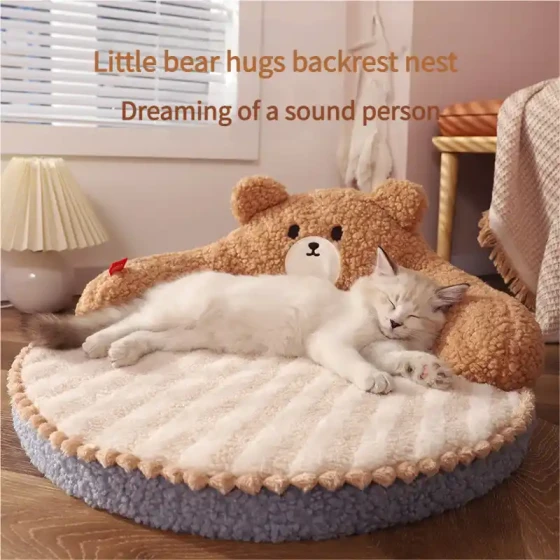Is Daytime Free-Roaming and Nighttime Cage-Raising Okay for Cats_Scientific Day-Night Management Tips for Cat Care
The model of allowing cats to roam freely during the day and being caged at night is theoretically feasible, but its success largely depends on the cat’s personality, the owner’s scientific management methods, and a deep understanding of the cat’s needs. This approach can provide cats with freedom to explore during the day while ensuring their safety and the owner’s rest at night. However, improper application might cause stress and behavioral problems for the cat.
For many “pet owners,” arranging a daily routine for their “cat masters” is a thought-provoking issue. Should cats be allowed to roam freely at home 24/7 without restriction, or be limited during specific times? Especially at night, when people are asleep, cats may engage in “night-time adventures,” creating a “havoc in heaven” show at home, such as jumping from heights, rummaging through cabinets, night running, or even tipping over water bowls. Therefore, for home safety, cleanliness, and ensuring the owner's sleep quality, some cat owners consider placing their cats in cages at night. But does this model truly meet the cat's nature, and what scientific day-night management tips exist?

1. Why Consider the “Daytime Free Roaming, Nighttime Cage-Raising” Model?
The original intention of this management model is often based on the following considerations:
- Home Safety and Hygiene: Caging cats at night can effectively prevent them from contacting potential dangers (such as wires, toxic plants, fragile items) while owners sleep, and prevent destructive behaviors at night, such as scratching furniture, rummaging through trash bins, or inappropriate elimination. For families raising kittens, caging is an effective way to prevent accidental ingestion of foreign objects and other accidents.
- Protecting the Owner’s Sleep Quality: Cats are typical nocturnal animals with abundant energy at night. Allowing unchecked nighttime activity may result in various noises, such as chasing and playing, flipping items, or scratching doors demanding food or attention, seriously disturbing the owner's sleep and causing fatigue the next day. Cage-raising can effectively limit nighttime activity, helping owners sleep peacefully.
- Establishing Regular Routines: Day-night management helps cats gradually synchronize their routines with their owners, understanding that daytime is for activity and play, while nighttime is for rest.
2. Potential Challenges of Cage-Raising and Coping Strategies
Although “daytime free roaming, nighttime cage-raising” has its advantages, not all cats can easily adapt, and improper handling may bring some negative effects:
- Stress and Anxiety: Cats are sensitive animals. If the cage environment is unsuitable, cramped, or lacks gradual training, caging may cause them to feel deprived of freedom, leading to stress and anxiety. Long-term high-stress cats may develop excessive grooming, loss of appetite, aggression, or depression.
- Behavioral Issues: Cats forced to cage may express dissatisfaction through calling or scratching the cage. If caging leads to insufficient space and playtime, daytime excess energy might lead to more destructive behaviors.
- Socialization Needs: Although independent, cats still need interaction and play with their owners. Overly long cage times or lack of high-quality companionship during the day may hinder social development and cause cats to become withdrawn.
3. Scientific Day-Night Management Tips for Cat Care
To smoothly implement the “daytime free roaming, nighttime cage-raising” model and ensure cats' physical and mental health, the following are crucial:
- Choose an Appropriate Cage:
- Size: The cage must be large enough to allow the cat to stand, turn, stretch, and accommodate food bowls, water, litter box, and resting areas. For an adult cat, a multi-level cage at least 80 cm long and wide and over 90 cm high is ideal, such as common “cat villas” on the market. Larger space means higher comfort and less stress.
- Interior Facilities: Inside the cage, place a comfortable cat bed (preferably hidden or semi-enclosed for security), drinking device, food bowls, necessary scratching boards, and a few toys. The litter box should be placed far from food and water.
- Material and Safety: Choose a sturdy, non-toxic, easy-to-clean cage without sharp edges or gaps that could hurt the cat.
- Gradual Adaptation Training:
- Positive Associations: When the cat is awake and relaxed, use the cage as a place to obtain treats and toys. For example, place snacks or favorite toys inside to encourage voluntary entry and exploration.
- Short Cage Times: Start with short periods of 10-15 minutes daily and gradually extend. Reward the cat each time and release the cat promptly upon good behavior. Avoid immediate release during anxiety or crying to prevent reinforcing negative behavior.
- Create a Comfortable Environment: Place the owner’s clothing with scent nearby or play soothing music to help the cat relax.
- Never Use as Punishment: Using the cage as punishment creates negative emotions and resistance to entering.
- Provide Ample Daytime Activity and Stimulation:
- High-Intensity Interaction: Ensure at least 2-3 times daily, 15-20 minutes each session, of high-intensity play, such as using a cat teaser wand to stimulate chasing and jumping, mimicking hunting to expend energy.
- Environmental Enrichment: Provide varied stimuli like cat trees, scratching boards, puzzle toys, and catnip toys so cats can play independently when owners are away.
- Vertical Space: Cats love heights; provide cat trees, window sills, and other elevated spaces to satisfy climbing and territory monitoring instincts.
- Establish Regular Routines:
- Fixed Feeding Times: Feed at consistent times daily, especially the last meal before nighttime caging, giving a sense of fullness to reduce night hunger.
- Pre-Sleep Play: Engage in a high-intensity game 1-2 hours before caging at night to exhaust energy and help the cat sleep easier once inside the cage.
- Create Nighttime Atmosphere: Dim lights and maintain quiet during nighttime caging to simulate a natural environment and encourage rest.
- Observe the Cat’s Signals:
- Closely monitor behavioral changes before and after caging, such as loss of appetite, excessive grooming, increased aggression, or inappropriate elimination. These signs may indicate stress from caging requiring adjustments in duration, environment, or training.
- If the cat shows clear anxiety or distress and cannot adapt despite training, this model may be unsuitable. Consider alternatives, such as selective area restrictions or larger enclosures.
4. Frequently Asked Questions
- Can cats spend the night in a cage?
Theoretically, yes. If the cage is spacious, comfortable, and the cat is properly trained, most cats can adapt to overnight caging. The key is meeting their physiological and psychological needs. - Does nighttime caging affect cats’ health?
If the cage is too small, environment poor, caging times too long, and daytime activity insufficient, it may cause excessive stress, behavior issues, and affect health. Properly managed caging ensures night safety and may benefit health. - What size cats are suitable for cage-raising?
Cats of all ages can be trained for caging. Kittens usually adapt more easily due to higher acceptance of new environments. Adult cats can also adapt with appropriate methods. - Does cage-raising affect the bond between cats and owners?
No. With sufficient daytime interaction and companionship, caging does not harm the relationship. On the contrary, regular routines help cats understand their owners’ schedules, promoting harmony. - How to determine if my cat is suitable for cage-raising?
Observe the cat’s personality. Independent, adaptable cats with good food motivation tend to adapt easier. Sensitive, clingy cats or those with separation anxiety may need longer adaptation and more care.
Summary
The “daytime free roaming, nighttime cage-raising” model is not a one-size-fits-all solution. It is a “double-edged sword” that provides safety and convenience, but also challenges the owner’s scientific management skills. Success hinges on fully understanding the cat’s physiological and behavioral needs, choosing a suitable cage, patient and positive training, and providing ample daytime activity and quality companionship. Ultimately, no matter the cat care model, the goal is the cat’s physical and mental well-being and a harmonious, joyful coexistence between the “cat master” and the “pet owner.”
References:
- International Society of Feline Medicine (ISFM) guidelines on cat welfare and behavior
- American Society for the Prevention of Cruelty to Animals (ASPCA) advice on cat behavior and environmental enrichment
- Authoritative pet behavior books such as "Cat Language Translator: A Guide to Cat Behavior for Pet Owners"
- Clinical experience and advice from veterinary clinics and pet behavior experts





